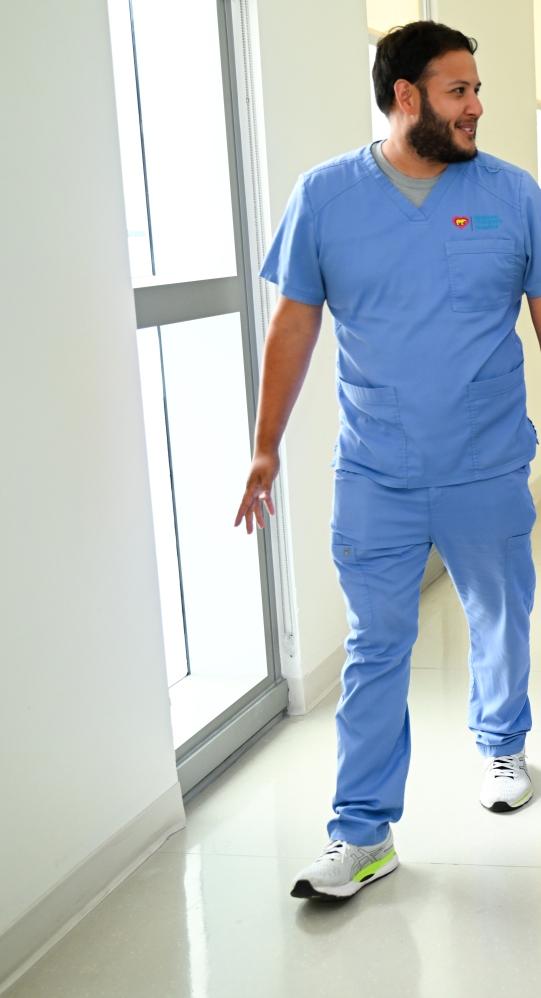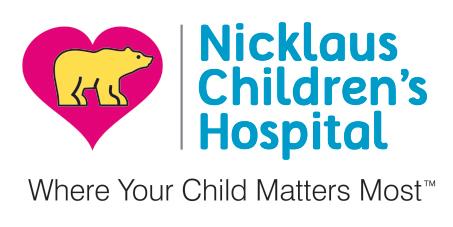Shaping




Pediatric nursing is not just a profession; it is a calling to care for the smallest and most vulnerable members of our society.







Pediatric nursing is not just a profession; it is a calling to care for the smallest and most vulnerable members of our society.






Nursingrepresentsbothanartofhealinganda
scienceofcarewithavitalhealthcarebackbone. Pediatricnursingdisplaysthistruthinitsperfect alignmentofexpertiseandcompassion,whichshapesthe futureoflittlepatientsinneed.
Healthcaresystemsdependonnursestofunctionas professionals,scientists,caregivers,andleadersinmedical pursuits.Pediatriccaregiversfunctionbothasprimarycare providersandleaderswhoalsoformulateinnovativecare methodsandactivelysupporthealthcareinitiatives.The evolutionofpediatriccaredependsontheleadershipof ChiefNursingOfficerswhoaretransformingclinical standardstoserveyoungpatients.Throughtheirdedicated leadership,CNOstransformhospitalsintohealing sanctuaries,whichprovidecomfortandhopetopatientsand families.
Theleadersinthehospitalperformoperationaloversight whilemotivatingtheirteamstouserevolutionarysolutions andconvertissuesintopossibilitiesforgrowth.Medical careforchildrenextendsbeyondmedicinesinceitinvolves buildingtrustalongwithshowingempathyandmaintaining apermanentfocusonaccomplishingexcellence.
Inthisspecialedition, Insights Care proudlypresents ‘ArchitectsofCare:ChiefNursingOfficersShapingthe FutureofPediatricNursing. ’Thiseditioncelebratesthe extraordinaryleaderswhoarerevolutionizingpediatric nursing,settingnewbenchmarks,andshapingafuture whereeverychildreceivesthebestpossiblecare.
Asyoureadtheirstoriesahead,mayyoubeinspiredby theirdedicationandleadership.Thefutureofpediatric nursingisnotjustbeingwritten,butitisbeingbuiltby theseremarkableindividuals.
Hope you have an inspiring read ahead!
- Pearl Shaw






08. P R O F I L E
Shannon Odell Championing Quality and Innovation in Children’s Healthcare
18. C X O
The Role of Business Development in a CRO
14.
20.
A R T I C L E S
The Quiet Crisis Addressing Lacking Nursing Leadership Education and Training Vaccines and Beyond Emerging Infectious Disease Management in Pediatric Healthcare



Brief
Arin Zapf Chief Nursing Officer
Daljit Athwal Chief Nursing & Midwifery Officer
Jesus Cepero
Senior Vice President & Chief Nursing Officer
Paula Eicker Chief Nursing Officer
Huntsville Hospital huntsvillehospital.org
Birmingham Women's and Children's NHS
Founda�on Trust bwc.nhs.uk
Stanford Medicine Children’s Health stanfordchildrens.org
UPMC Children's Hospital of Pi�sburgh chp.edu
Arin is an experienced nursing expert managing clinical teams, ensuring excep�onal care standards, and driving innova�on in a major medical facility
Daljit is a compassionate leader guiding nursing and midwifery services, enhancing pa�ent outcomes, and suppor�ng staff in a specialized women’s and children’s trust.
Jesus is a strategic healthcare professional direc�ng nursing ini�a�ves, improving child health services, and fostering excellence in a leading pediatric organiza�on.
Paula is a dedicated healthcare leader overseeing nursing opera�ons, pa�ent care quality, and staff development at a renowned pediatric hospital.
Shannon Odell Vice President & Chief Nursing Officer
Nicklaus Children's Health System nicklauschildrens.org
A pediatric nursing leader with exper�se in bedside care and strategic innova�on, Shannon drives quality improvement and elevates pa�ent care standards na�onally


Shannon Odell Vice President and Chief Nursing Officer Nicklaus Childrenʼs Health System
Inpediatrichealthcare,chief
nursingofficers(CNOs)playa criticalroleinensuringthat patientsreceivethehigheststandards ofcare.Amongthesededicated professionalsisShannonOdell,MSN, RN,FACHE,NEA-BC,CENP, RNCOB.AstheVicePresidentand Chief NursingOfficeratNicklaus Children'sHealthSysteminMiami, Florida,sheshowcasesthe commitmentandinnovationneededto advancepediatricnursing.
Shannon’sjourneytobecomingachief nursingofficerisbothinspiringand instructive.Withacareerbackground inpediatric,obstetric,andneonatal nursing,Shannonhasspentyears refiningherexpertiseandleadership skills.Herexperiencespansfrom hands-onbedsidenursinginmedical, surgical,obstetric,neonatal,and pediatricunitstostrategicleadership rolesdrivingqualityimprovementand evidence-basedpracticestandards. Thisdiversebackgroundhasuniquely positionedhertoleadandinnovatein pediatricnursing,alwayswithafocus onenhancingpatientcare.
AtNicklausChildren’s,Shannon’s impactreachesbeyondtheclinical world.Sheisakeyleaderinshaping thehospital’smissionandvision, ensuringthatstrategicinitiativesalign withthehealthsystem’scommitment topediatriccare.Herworknotonly
impactsthelocalcommunitybutalso setsastandardforpediatricnursing excellenceonanationallevel. Shannon’sleadershipisatestamentto theprofoundimpactthatdedicated nurseleaderscanhaveonhealthcare systemsandpatientoutcomes.
Fromherearlydaysasabedsidenurse, Shannonwasdrawntotheunique challengesandrewardsofcaringfor womenandchildren.“Witnessingfirsthandthechallengesthatmanychildren faceandthepositiveimpactIwasable tomakeasanursewasincredibly inspiringandhumbling,”sheshares. Thisdeeppersonalconnectiontoher patientshasbeenadrivingforce throughouthercareer
Herpathincludedrolesinmaternity services,pediatricdepartments,and withinthehospitalfloatpool,where shegainedextensiveexperience workingwithdiversepatient
populations.Shannon’sfocuson pediatricandneonatalnursingwas furtherstrengthenedbyher commitmenttoqualityimprovement andintegratingevidence-based practicestandardsintopatientcare.“In thespaceofwomenandchildren,Iwas abletostartlookingmorecloselyat qualityimprovementandevidencebasedpracticestandards,whichhelped toimprovecareandwasincredibly rewarding,”sherecalls.
Shannon’spersonalexperiencesasa motherandgrandmotheralsoinform herprofessionalapproach.“Beinga motherisaprivilege.Iwantthebest formyownchildrenandnowmy sweetgrandchildren.Thisdeep personalexperienceinformsmy practiceanddrivetoimprove,”she explains.Herjourneyisapowerful exampleofhowpersonaland professionalexperiencescanintertwine tocreateacompassionateandeffective nurseleader
In nursing, we are constantly pursuing excellence – we cannot be satisfied with the status quo. If we are not growing, we are stagnating.
“Settingthevisionasthechiefnurseis anhonor–Ihavetheopportunityto evaluatethetruenorthandmakesure thatourstrategiesalignwithour missionandvision,”shestates.This strategicoversightensuresthatthe hospital’snursingpracticesremain alignedwiththeircommitmenttohighqualitypediatriccare.
NicklausChildren’sHealthSystem’s distinctionastheonlyfreestanding pediatrichospitalintheregion significantlyshapesShannon’s approachtonursingleadership. Shannonemphasizestheimportanceof advocatingfortheuniqueneedsof pediatricpatientsandtheirfamilies. “Kidsarenotlittleadults–wesaythis allthetime.Weneedtoadvocatefor theuniqueneedsofeachpatientand family,whetherlocally,atthestate level,ornationally,”sheexplains.This advocacyextendstobothclinicalcare andlegislativeissues,highlightingher comprehensiveapproachtopediatric nursingleadership.
Inherrole,Shannonalsofocuseson fosteringacultureofcontinuous improvementandexcellencein nursing.“Weareconstantlypursuing excellence–wecannotbesatisfied withthestatusquo.Wemustcontinue toengageinopportunitiesfor professionalgrowth,therebyadvancing careaswellasourcareers.Ifweare notgrowing,wearestagnating,”she asserts.Hercommitmenttogrowthand innovationisthefoundationofher
leadershipphilosophy,drivingthe hospital’seffortstoenhancepediatric care.“Ourstaffisareflectionofour patientpopulation,andwearea meltingpotofculturesandlanguages. Thisallowsustoprovideculturally competentcare,”sheexplains.This diversityisastrengththatenhancesthe hospital’sabilitytomeettheneedsof patientsandtheirfamilies.
UnderShannon’sleadership,Nicklaus Children’sHealthSystemhas implementedseveralinnovative nursingpracticesdesignedtoenhance thecareandexperienceofpediatric patients.Onesuchinnovationisthe virtualreality(VR)technologyusedin theemergencydepartmenttoreduce proceduralanxiety.“Weinnovateto reducestressandanxietyforpatients, usingtoolslikeVR,whichincorporate playintothecareexperience,” Shannonexplains.Theseinnovations reflectthehospital’scommitmentto creatingachild-friendlyenvironment thatsupportsbothmedicaland emotionalwell-being.
Othernotableinitiativesincludethe BabySteps program,whichsupports thetransitionofcareforNICUpatients andtheirfamilies,andtheHumpty DumptyFallsPreventionProgram,a tooldevelopedbythehospitalto identifyandmitigatefallrisksfor pediatricpatients.“Wearethe developersoftheHumptyDumpty FallsPreventionProgram,whichis

nowusedgloballytoidentifypatients atriskoffallandpreventnegative outcomes,”Shannonproudlystates.
Theseprograms,alongwithothers, demonstratethehospital’sproactive approachtopediatriccare.Byfocusing onbothclinicalexcellenceandpatient experience,NicklausChildren’s continuestosetthestandardfor pediatricnursing.“Becauseofour strongresearch,evidence-based practice,andscholarshipfocus,weare leadersingeneratingandtranslating evidencetoelevatepediatriccare,” Shannonhighlights.
Shannonbelievesthateffective collaborationacrossdifferent healthcaredisciplinesisessentialto improvingpediatriccare.
“Multidisciplinarydailyrounds,many ofwhicharenurse-led,facilitate interprofessionalcollaboration,”she explains.



Theseroundsensurethatallmembers ofthehealthcareteamarealignedand workingtogethertoprovidethebest possiblecareforpatients.
Thehospitalalsopromotes interdisciplinarycollaborationthrough itsProfessionalGovernancemodel, whichisopentodifferentdisciplines, anditsClinicalEffectivenessProgram.
“Nursesareinvolvedinhospital-wide committeesandprovideleadershipon taskforcesaddressingkeyissues facingourpatientsandthefamilieswe serve,”Shannonnotes.These opportunitiesforcollaborationand shareddecision-makingenhancethe hospital’sabilitytodeliver comprehensiveandcoordinatedcare.
NicklausChildren’sfurthersupports professionaldevelopmentand translationofevidencethroughevents liketheNicklausChildren’s ScholarshipWeek,whichbrings togetherphysicians,nurses,andallied healthprofessionalstosharebest practicesandresearchfindings.
“NicklausChildren’sScholarship Weekallowsnursestosharenursing innovationandresearch,evidencebasedpractice,andquality improvementwithourcolleagues,” Shannonhighlights.Theseinitiatives fosteracultureoflearningand continuousimprovement,whichis centraltothehospital’smission.
Shannonoffersvaluableadvicefor aspiringnurseleaderswhowishto specializeinpediatricnursing.She emphasizes,“Committolifelong learning–read,lookforopportunities toengageandbecomeinvolved, becomeanactivememberofa professionalnursingorganization, obtainaprofessionalcertificationin yourspecialty,pursueadvanced degreesinnursing.Neverstoplooking forwaystogrowandmakea difference.”
Shannonalsoencouragesaspiring leaderstoseekmentorshipandtakeon leadershiproleswithintheircurrent positions.“Lookforopportunitiesto engagewithamentorandbewillingto providesupporttoamenteeaswell. Getinvolvedinopportunitiestoserve asaleaderinyourcurrentrole–bea chair/co-chair,stepuponkey committees,”shesuggests. Sheisalsocommittedtochangingthe dialoguearoundnursing.“Weneedto makesurenursingisportrayedasa rewardingandexcitingfieldof healthcare,”shesays.“Toooften, negativeaspectsofthenursing professionarefrontandcenter,while anoverwhelmingnumberofaspectsof ourjobsareincredibleandinspiring. Peoplewhochoosenursingastheir careerareextremelymotivatedand willfinditahighlyrewarding experience.”
Ultimately,Shannonbelievesthat stayingcuriousandcommittedto excellenceiskeytosuccessin pediatricnursing.“Strivetobecomean expertinyourcurrentareaofpractice. Thiswillallowyoutoadvocatefor yourpatientsandfamiliesaswellas evidence-basedprofessionalnursing practice,”sheconcludes.Heradvice highlightstheimportanceof dedication,curiosity,andcontinuous growthinthenursingprofession.

In pediatric nursing, we don’t just care for the body, we care for the heart and soul of the child and their family.




Thenursingprofessionreliesonboth
tendernessandspecializedmedicalskills togetherwithcompassion.Thecurrent demandinghealthcareenvironmentrequires dependableleadershipjustasmuchasexperienced clinicalpractitioners.Therisingnecessityfor professionalnursingleadersfaceseducationand trainingdeficitswhichleadershipresponsibilitiesfail toreceiveproperattention.Thissilentcrisisproduces extensiveimpactswhichaffectbothpatientresultsand healthcaregroupperformanceandsystemoperational effectiveness.Thefutureofhealthcaredependson resolvingtheinsufficienttrainingandeducationwhich nursingleadershipcurrentlyfaces.
Nursingleadershipdeliversvaluebysupervising employeegroupsandsimultaneouslyleadingsystem adjustmentsandadvocatingpatienthealthandaltering healthcareguidelines.Nurseleadersmaintainessential operationalpositionsbyensuringbothhigh-quality servicedeliveryandworkforcespiritandoperational improvementsinhealthcarefacilities.Healthcare responsesduringtheCOVID-19pandemicdepend heavilyonleadershipabilitiesandresiliencebecause strategicdecision-makingbecomesvitaltoachieve effectiveresults.





Nurseleadersperformthreeessentialrolesintheir professionalactivitiesbymentoringstaffmembers andprovidingrolemodelexampleswhileadvocating ontheirbehalf.Throughtheirwork,nurseleaders connectnurseswithhealthcareadministratorsto guaranteedirectparticipationinpolicycreation approaches.Theirguidancepromotesanenvironment oflifelonglearning,whichenablesnewnursing professionalstobuildleadershipabilitiesinearly stagesoftheircareers.
Theessentialroleofleadershipinnursingexists againstaneducationaldeficitcombinedwith insufficienttrainingprograms.Thecurriculaof nursingprogramsmainlyteachmedicalcompetencies ratherthandedicatingeducationalcontentto leadershipskillsdevelopment.Themajorityofnurses starttheircareerswithoutessentialleadership capabilitiesbecauseeducationsystemsdonotprovide adequatetraining.Moreover,leadersinnursingtake theirpositionswithoutreceivingspecificeducation aboutthisprofession.
Severalfactorscontributetothisgap:
1. LackofLeadershipCurriculuminNursing Programs:Traditionalnursingeducationalfocus onclinicalcompetenceneglectstoprovide leadershipeducationalprograms.Theleadership educationcomponentinnursingprogramsexists onlyasshorttheoreticallessonsthatdonotdeliver practicalexecutioncapabilities.
2. LimitedAccesstoMentorshipandProfessional Development:Nursesfacerestricted opportunitiestoaccessmentorshipprograms alongwithprofessionaldevelopmentprograms whichhelpsleadersdeveloptheirskills.New leadersinhealthcarefaceachallengingtaskof understandingcomplexleadershiprequirements becausetheylackexperiencedmentorshipfrom nurseleaders.
3. WorkplaceBarrierstoLeadershipGrowth: Nursingworkpresentsexcessiveamountof demandsthatreduceavailabilityforleadership trainingopportunities.Thecombinationof extensiveworkloadsandshortagesofstaffalong withburnoutputssignificantobstaclesinfrontof nurseswhowanttocontinuetheirlearningor developtheircareers.
4. InsufficientSupportfromHealthcare Organizations:Manyhealthcareorganizations lacksystematicleaderdevelopmentstructures whichforcesnursestoindependentlyfindtheir ownprofessionaltraining.Healthcare organizationsthatdonotoffersupporttotheir nurseslimitthedevelopmentofproficientnursing leadership.
TheImpactofInsufficientLeadershipTraining
Ashortageofexperiencedleadershipcreatessevere negativeeffectsfortheprofession.Weaktraining programspreventnurseleadersfromadequately managingdecisionsandteamsandadvocatingfor policies.Inadequateleadershipresultsindissatisfied workersalongwithelevatedstaffdeparturerates accompaniedbyreducedstandardsofcaredeliveryto patients.Themainurgentissueswhichemergefrom deficientleadershiptraininginclude:
• HigherNurseBurnoutandTurnover: Inadequateleadershippracticesgeneratehigher ratesofstaffburnoutaswellashigherturnoverin nursingprofessionals.Adeficiencyinleadership capabilitiestosupportteammembersdiminishes nursemoralewhichtriggersincreasedstresslevels thatdrivenursestoleavetheirpositions.
• ReducedPatientOutcomes:Patientssufferfrom negativeresultswheninadequateleadership enablespoorcommunicationandmistakesthat resultinsubstandardqualitymedicalcare.The presenceofstrongleadershipformsanabsolute requirementtobuildanenvironmentfocusedon safetyandaccountability.




• LackofInnovationinNursingPractice: Nursingpracticeremainsstagnantwhennurses lackproperleadershipdevelopmentsinceit regulatestheirparticipationininnovationresearch andpolicydevelopmentactivities.Therestricted advancementofnursingsciencetogetherwith limitedhealthcareenhancementbothsufferasa result.
Acompletemethodologyshouldbeusedtoresolve theleadershipdeficiencyproblemwithinnursing.The proposedsolutionsmustincorporateleadership educationinnursingcurriculumwhileoffering continuoustrainingaswellasmentorshipand professionaldevelopmentprograms.
1. Nursingeducationatschoolsmustinclude leadershiptrainingthroughoutallitseducational content.Beforenursesjointheworkforcethey needrealisticexperiencesthroughleadership simulationsandteam-basedprojectstogain practicalskills.
2. Healthcareprogramsshouldestablishorganized programsthatpairmentorswithcoachestohelp nursesbuildleadershipcompetencies. Experiencednurseleadersneedtoprovidedirect supportandinstructiontodevelopingnursing leaders.
3. Medicalestablishmentsneedtofundprograms thatsupporttheongoingdevelopmentof healthcareleadersbyrunningleadership developmentworkshopstogetherwithspecialized trainingsessionsalongsideeducational advancementcourses.Professionaldevelopment opportunitiesmustreceivebothfinancialbacking andtimeextensionstosucceed.
4. Institutionsneedtodevelopsystemsthat recognizeandrewardleadershipdevelopment amongtheirstaff.Healthcareinstitutionsshould createopportunitiesforleadershipadvancement withinnursingsettingstoinspirenursestoward assumingleadershippositions.
5. Theuseoftechnology-basedleadershipeducation throughdistancelearningactivitiescombinedwith virtualprogramsandmentorshipleadsnursesto obtainflexibleeducationalopportunitiesthatwork fortheirdemandingclinicalschedules.
Healthcarefacesasubstantialchallengebecauseofthe ongoingquietcrisisthatresultsfrominadequate educationandtrainingofnursingleadership.The resolutionnecessitatesjointworkbetweennursing educatorsandhealthcareexecutivesandgovernmental representatives.Engaginginleadershipdevelopment programswillhelpthenursingprofessioncreate skilledleaderswhobringpositivetransformations, superiorpatientresultsandenhancedhealthcare infrastructure.Modernhealthcaredependson immediateinvestmentinnursingleadership developmentbecausesuchleadershipmeasuresthe foundationforbetterhealthoutcomesacrosssociety.
-Natalie May
Francisco Javier Tejero is a pharmacist with over 8 years of experience in the pharmaceu�cal, biotech, and medical device industries. Throughout his career, he has worked on developing innova�ve healthcare strategies, project management, and leading mul�disciplinary teams. He currently leads Matraz Innova, a company focused on digital transforma�on and the implementa�on of technological solu�ons in the healthcare sector, providing services in business development, CRO, regulatory affairs, pharmacovigilance, medical affairs, quality, and so�ware development.
His approach centers on integra�ng ar�ficial intelligence, data management, and medical educa�on to enhance efficiency and decision-making in the industry Addi�onally, he has par�cipated in strategic projects for both private companies and public administra�ons.
Passionate about innova�on and entrepreneurship, Francisco Javier has driven various ini�a�ves, including a knowledge-sharing and podcas�ng pla�orm. His business vision has led him to explore new opportuni�es in key sectors such as healthcare digitaliza�on and process op�miza�on in regulatory affairs.



The Key to Driving Innovation in Clinical Research
Intheworldofclinicalresearchandthepharmaceutical industry,ContractResearchOrganizations(CROs) playacrucialroleinexecutingclinicaltrials.However, behindthesuccessofeachstudy,thereisanessentialteam that,althoughnotworkinginthelaboratoryorwith patients,isdecisiveindrivinginnovationforward:the BusinessDevelopmentteam.Butwhatexactlydotheydo? Whyaretheysoimportanttothecompany?
Morethanjustacommercialfunction,theBusiness Developmentteamisthestrategicenginethatdrivesthe growthofCROs.Theirworkisnotlimitedtoclient acquisition;theylayouttheroadmapforthesustainability andexpansionoftheorganization,meaningthecompany dependsonthem—theyarethefuelthatkeepseverything movingforward.EveryprofessionalinaCROplaysan importantrole,fromclinicaltrialmonitorstodata managers,butwithoutadoubt,theBusinessManager understandstheeconomicfeasibilityofclinicaltrials, identifiesnewbusinessopportunities,andestablishes strategicallianceswithpharmaceuticalandbiotechnology companies.
Managersensurethatthestudieshavethenecessary resources,fromplanningtoexecution,thusensuringtheir feasibilityandprofitability
Furthermore,theBusinessDevelopmentExecutiveisthe architectoforganizationalgrowth.Theirroleinvolves analyzingthemarket,identifyingemergingtherapeutic
areas,andestablishingstrategicrelationshipswithnew playersintheindustry Theyalsodeveloptheirown businessunit,manageateamofbothsalespeopleand consultants,andhandletheirclientportfolio.
ThemanageralsofocusesontheentireoperationofMarket Research,P&L,LegalAgreements,andNegotiations—no easytaskforthoseseekingaquietlife.
So,howcanonestandoutinsuchademandingmarket?
Thekeytobeingexceptionalisdedicatingyourtimeto thoroughlyunderstandingtheclient’sneeds,researchingthe mostsuitableoption,andmakingthebestprojectoffer, alongwithfollowingup.Notallclientshavethesame needs,andsomemaynotrequireyourservices,soatthat moment,itisimportanttoexplaintheavailableoptionsto theclient.
Withoutadoubt,themostimportantfactortobeinga managerisself-confidenceandadeepunderstandingof yourmarket.Havingpriorexperienceinthepharmaceutical industryandhospitalscangiveyouaninsightintohowthey operateinternally,allowingyoutoaddressanydoubtsand supportthemthroughouttheirentireprocess.




Infectiousdiseasesemanatefromtinygermsincluding
bacteria,viruses,fungiandparasites.Differentdiseases havetheabilitytotransferbetweenindividualseasily Infectiousdiseasesleadtoillnesssymptomsthatmay includefeverandcoughinadditiontorunnynasalpassages. Mostinfectionsarenotseverebutcertaintypescanbecome dangerousparticularlyforchildren.
Quicklyspreadingdiseasesthatemergeasnewinfectionsor showchangestotheirnaturearereferredtoasemerging infectiousdiseases.Certaindiseasespresentthemselvesin differentareasandspreadtolargernumbersofpeople.The worldfacesnewdiseaseswhichincludeCOVID-19 alongsideZikavirusandnewtypesofflu.Suchdiseases presentriskstodoctorsbecausemedicalstaffhavelimited knowledgeaboutinitialtreatmentapproaches.
Theimmunesystemofchildrenremainsunderdevelopment whichmakesthemhighlysusceptibletoinfections.Medical specialistscombinedwithscientistsdedicatetheireffortsto preventinfectionsamongchildrenbyusingvariousmedical approaches.Someofthebestwaystokeepchildrensafe include:
• Vaccines
• GoodHygiene
• HealthyEating
• MedicalResearch
• QuickIdentificationandResponsetoNewDiseases
• CommunityAwarenessandPreventionPrograms
Vaccines:TheFirstLineofDefense
Thebestdefenseforchildrenagainstinfectionsemerges throughvaccinesasaprotectivemeasure.Vaccination enablesthebodytolearngerm-fightingtechniquesbefore infectionsoccur
Avaccineprovidestheimmunesystemwithbiological exercisesforlaterdefenseagainstinfections.Avaccine againstaspecificgermhelpsthehumanbodyunderstand howtoidentifyanderadicatethetargetpathogen.Exposure toauthenticpathogensbecomespossiblelateryetthechild's bodywillrespondquicklytoeliminatethem.
Whilevaccinesareveryimportant,thereareotherwaysto protectchildrenfrominfections.Herearesomekeysteps:
Washinghandswithsoapandwaterisoneofthesimplest andbestwaystopreventinfections.Kidsshouldwashtheir hands:
• Beforeeating
• Afterusingthebathroom
• Afterplayingoutside
• Aftersneezingorcoughing
Thebodycansuccessfullybattleinfectionsbecauseofa strongimmunesystem.Eatingfruitsvegetablestogether withwholesomefoodsallowsustoprovideourbodywith itsneededvitaminsandminerals.Astrongbodyresults whenpeopledrinkplentyofwaterandachieveadequate rest.
Physicalexercisestandsasanessentialapproachto maintaininggoodhealth.Playingoutstandingactivities combinedwithrunningandjumpingactasvitalmethodsto buildbodystrengththathelpsresistinfections.
3.
Doctorsandscientistsusedailyworkroutinestoinvestigate newdiseasesalongwithdevelopingmedicinesand immunizationsfordiseaseprotection.Themedical workforcedevelopsinnovativepharmaceuticalpreparations andtherapeuticsolutionstogetherwithimmunization agentsfordefendinghumanpopulations.Newdiseases bringhealthcarestafftoquickactionforpreventingtheir transmissiontoothers.
Hospitalstogetherwithmedicalcentersremainreadyto respondtoupcomingdiseaseoutbreaks.Thestaffmembers receivetrainingalongsideusingprotectiveequipment whichprotectsdoctorsandpatientsfromharm.
Thetrackingofdiseasespreaddependsontechnological systemsoperatedbydoctors.Scientistsoperatespecial hardwaretoexaminegermstogetherwithtrackingtheir paththroughhumancontacts.Usingthegathered informationhealthcareprofessionalswarncommunitiesto preventinfectionsfromspreading.
Throughtheirpartnershipdoctorsestablishsafetyprotocols whichschoolsandgovernmentalauthoritiesandcommunity membersenforceinordertoprotectchildren.Whenflu casesriseschoolsremindstudentstostayhomeinorderto stopthediseasefromspreadingacrossthecommunity
Underthesupervisionofcommunitieschildrenbenefitfrom beingprotectedagainstinfectiousdiseases.Health organizationstogetherwithschoolsdeliverawareness programswhichteachdiseasepreventionknowledgeto bothparentsandchildren.Educationalprogramsfocuson teachingstudentsabouthygienepracticestogetherwith howtoreceiveanddetectillnessesearly Thegovernment activelysupportscommunitywell-beingbyproviding vaccinesavailablefreeofchargetochildren.
Publichealthofficialsimplementdiseaseoutbreak managementthroughquickcontainmentprocedures.
Doctors,nurses,andhospitalsplayabigpartinkeeping childrensafefrominfections.They:
• Givevaccines
• Treatsickchildren
• Educatefamiliesaboutgoodhealthpractices
• Studynewdiseasesandfindwaystostopthem
• Provideemergencycareforchildrenwithserious infections
• Developsafetyguidelinestopreventthespreadof illnesses
Medicalprofessionalsconductexaminationstodetermine whichinfectiousagenttriggersillnessesinsickchildren. Thehealthcareteamimplementsthemostsuitabletreatment methodeitherthroughprescribingmedicationoradvising restperiodswithintakeoffluids.Thehospitaloperates isolationzonesspecificallydesignedtostopcontagious diseasepatientsfromspreadingtheirinfectionstoother patients.
Toprotecttheirchildren,familiescan:
• Makesurekidsgettheirvaccinesontime
• Teachkidsgoodhygienehabits
• Takechildrentothedoctorforcheck-ups

• Keepsickkidsathometostopgermsfromspreading.
• Stayinformedaboutnewdiseasesandfollowhealth guidelines
• Childrenshouldbeencouragedtoexerciseandeat healthy.
Familiesthattakeprecautionstokeeptheirkidshealthy alsocontributetothesafetyofotherchildrenandadultsin theirneighborhood.Inordertocontrolthespreadof illnesses,collaborationiscrucial.
Whenitcomestostoppingthespreadofinfectiousdiseases amongyoungsters,schoolsarecrucial.
• Childrenarealsotaughtinschoolsthevalueof immunizationsandmaintaininggoodhealth.
• Tokeepstudentssafe,theymightprovidehealth examinationsorfluvaccines.
• Keepclassroomscleananddisinfectsharedsurfaces
• Encouragestudentstostayhomeiftheyfeelsick
• Workwithhealthofficialstomanageoutbreaks
Schoolsalsoeducatechildrenabouttheimportanceof vaccinationsandstayinghealthy Theymayofferflushots orhealthcheck-upstostudentstoensuretheystay protected.
-Natalie May






Being a pediatric nurse means being a constant source of support, compassion, and hope for children in need.

